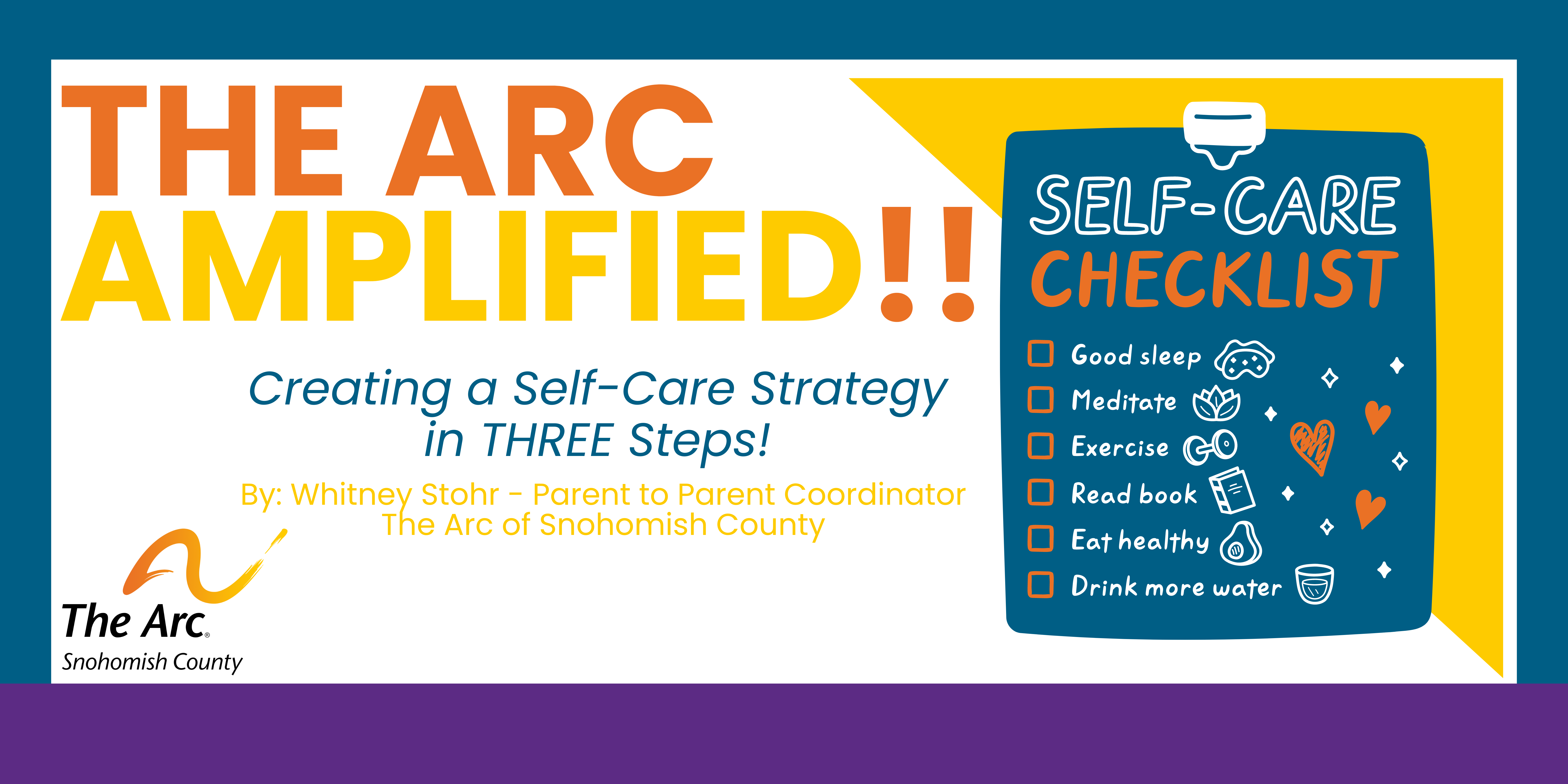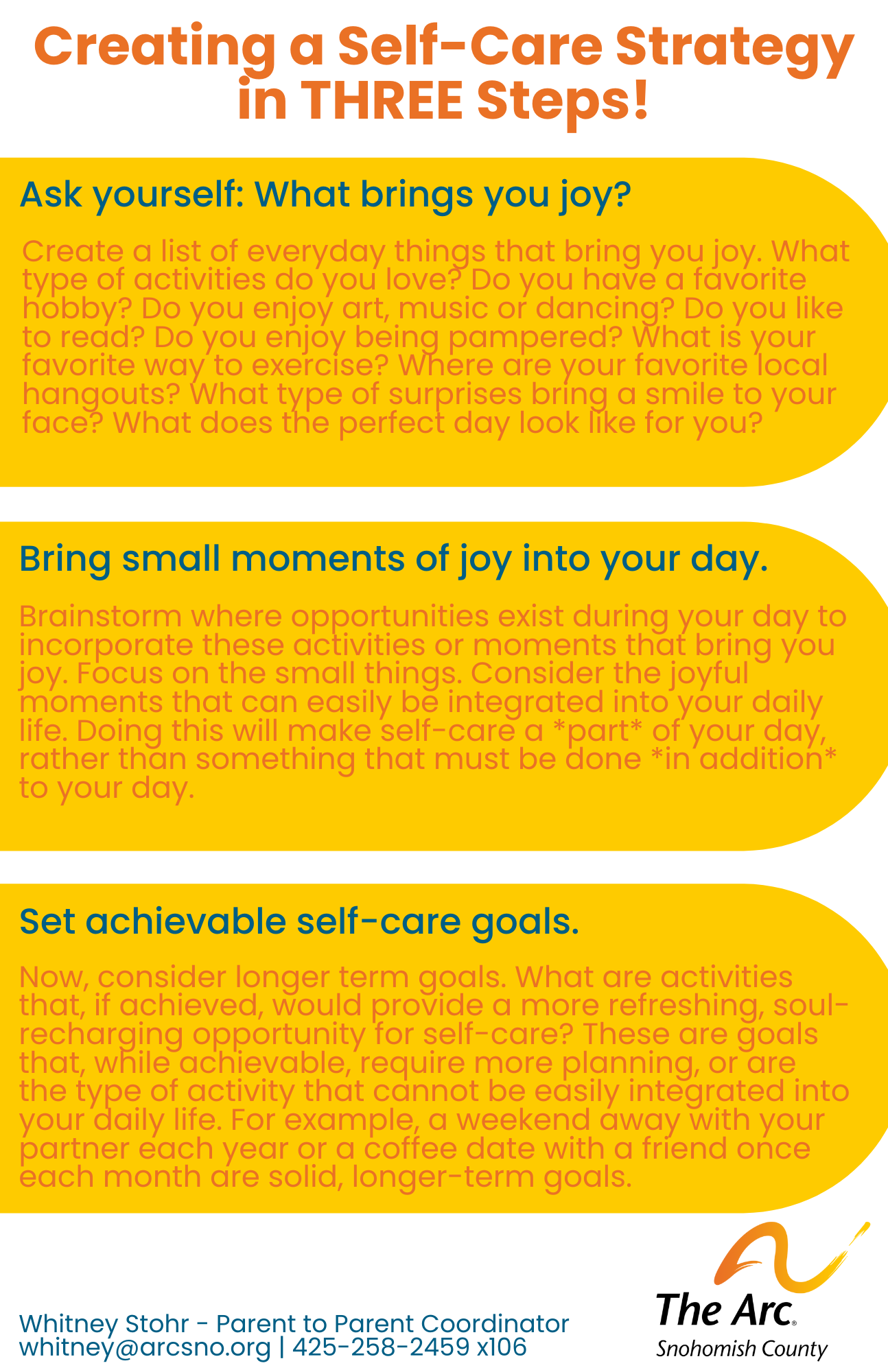
Creating a Self-Care Strategy in THREE Steps!
The buzz about “self-care” is everywhere!
It is difficult these days to access any social media platform without scrolling across one or two (or three or four…) mentions of self-care. Whether it is a friend sharing about her recent re-commitment to self-care following a particularly busy period of family changes (good for her!) or a news site sharing an article by a well-known expert in personal wellness, the reminders abound that self-care, despite its current buzz-worthiness, is both important and necessary for all of us.
That factor of necessity perhaps garners even greater truth when applied to the role of parenting. The day-to-day requirements of running a household, working and caring for young children and other family members rapidly absorbs whatever time you could possibly hope to find for a moment alone. Then you add in the medical, nursing, therapy and other responsibilities tied to the role of caregiving for a child with a disability, and… forget about it!
Self-care is often the very last thing on our minds as family caregivers of children with disabilities and complex medical needs. You get going, going, going and — all of a sudden — it is already 9 PM and you have no idea where the day went.
And yet… self-care remains as important for family caregivers as anyone else.
(I would argue that self-care is actually far more important for family caregivers than the general population based on research showing the heightened health risks and overall wellness challenges resulting from caregiving.)
And yet, still… it remains so hard to fit into your day. You know it is important. You want to focus on self-care and all the things that bring you joy, and your passions and your interests and your hobbies…. but, you have SO MUCH to get done! Every day.
I get it. As a family caregiver, this is a mental battle I fight with myself — Every. Single. Day. And then, I read another study about the impacts of caregiving on family caregivers, and it serves as another reminder that we MUST take care of ourselves. We MUST!
But, how?
If we think of self-care in terms of moments that bring us joy, however brief, and activities that lift our spirits, however simple, then the practice of self-care transforms into something attainable. If we give ourselves grace and view self-care as a practice that can grow with us through the years of caregiving, then we might learn to view self-care as a lifestyle, rather than an item to check off our daily to-do list.
Here are THREE STEPS to help you create a self-care strategy that works for you:
Step 1: Create a list of activities, interests and items that bring you joy. Begin by free-writing. Jot down whatever pops into your head. Consider activities or hobbies you love. What brings a smile to your face? Is it art, music, dancing, running or working with your hands? Do you like to read? What does “pampering” look like for you? Remember to include places and activities you enjoy outside the house. Add your favorite local hangouts to the list. Do you have a favorite coffee shop or bakery? Does a trip to the library renew your spirit? Is it swimming laps at the local aquatic center or volunteering at a nearby dog shelter? Write it down — whatever it is, no matter how big or small.
Step Two: Incorporate moments of joy into your day. Review your list and brainstorm where opportunities exist throughout your day to incorporate these activities to create moments of joy. This is self-care. Focus on the small things that can be easily integrated into your daily life. Ask yourself: What small changes can I make that will easily become self-care habits? Doing this will make self-care a *part* of your day, rather than something that must be done *in addition* to your day.
Step Three: Set achievable self-care goals. Now, consider longer term goals. Ask yourself: What would it take for my soul to feel fulfilled? Consider those items on your list that lend themselves to long-term practice, and create for yourself goals that, while achievable, may require additional planning and effort beyond your daily responsibilities. These are goals to work toward. It may take a while to fold them into your routine and that is completely expected. These are goals that can drive you and encourage you along your journey in personal self-care.

Note: This three-step strategy to conceptualize and develop a self-care routine was first presented at the “Caregiver Connections” support group meeting on February 15th, 2022. Caregiver Connections is a monthly, self-care centered support group for parents and family caregivers of children with disabilities. The group meets on the 3rd Tuesday of each month at 7 pm. For more information or to register, visit The Arc of Snohomish County event calendar online at arcsno.org/calendar.
Are you interested in creating a more in-depth self-care plan as a family caregiver? The Family Caregiver Alliance offers some great strategies in this article: tinyurl.com/37dnedbd.
**********
Whitney Stohr is a Parent to Parent Coordinator at The Arc of Snohomish County. She is passionate about advocating for medically complex children and children with disabilities and their families. She is a mom and medical caregiver herself, who is energized by working closely with other parent/family caregivers. She lives with her four-year-old son Malachi and husband Jason in Lynnwood. Connect with her on Instagram @rollin.w.spinabifida. Contact: whitney@arcsno.org.

